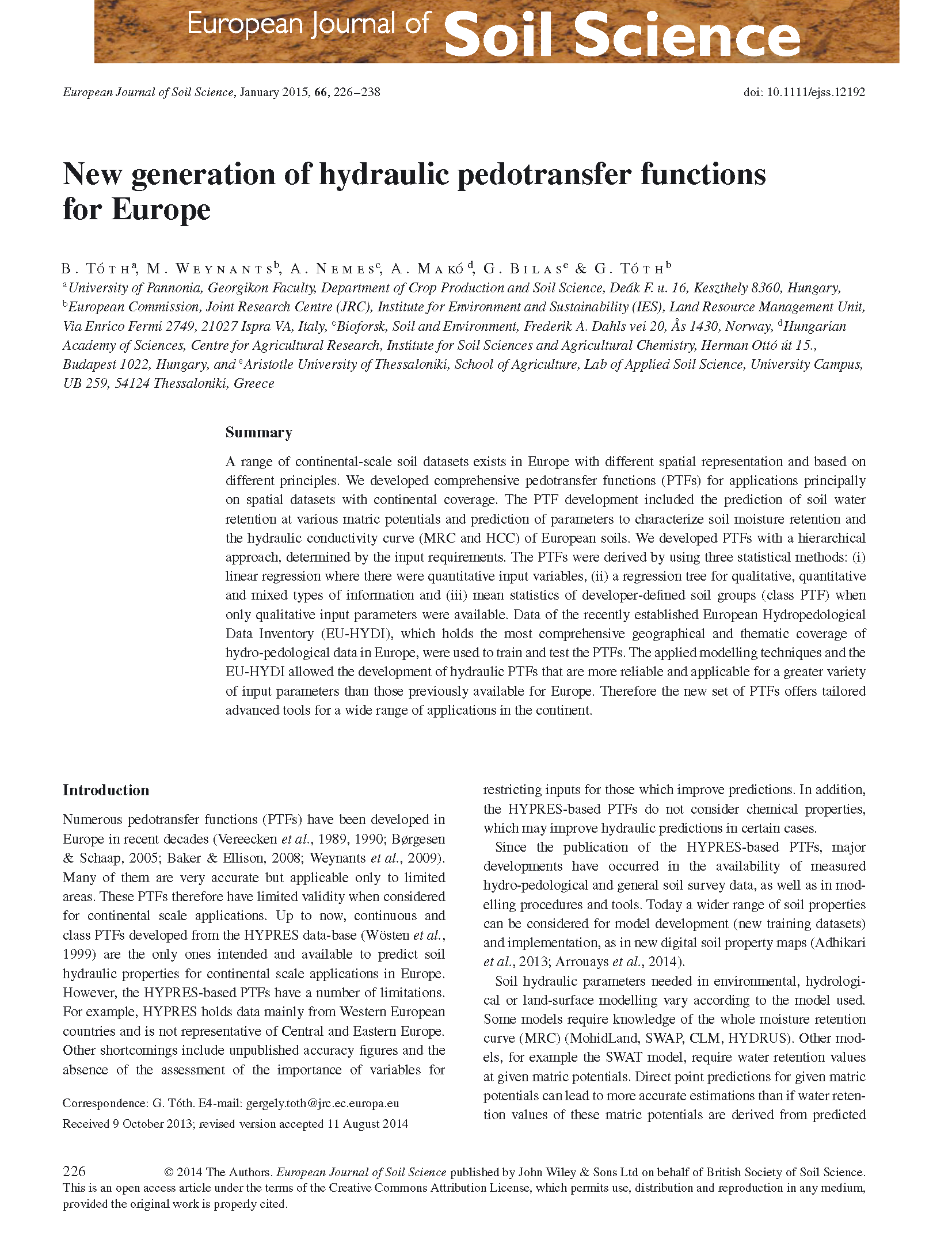
You are here
Soil Hydraulic Properties
Introduction
Soil hydrological properties have an important role in soil functions. Their predicted values are used in agronomic and hydrological models, which have wide ranges of analytical and planning applications. From the support of irrigation, soil management and plant breeding planning, to studies on the effect of land use or climate change, these models are applicable in nearly all fields, where soil and water interactions are considered. However the required data on soil hydrological properties to operate these models are often not available or difficult to measure. Therefore it is attractive to estimate these properties from soil information which is available, or easy to produce. Mathematical functions to estimate soil hydraulic parameters from basic soil information, such as soil texture, organic carbon content, bulk density etc. are called pedotransfer functions (PTFs).
Soil hydraulic parameters needed in environmental, hydrological or land-surface modelling vary according to the model used. Some models require knowledge of the whole moisture retention curve (MRC) (MohidLand, SWAP, CLM, HYDRUS). Other models, for example the SWAT model, require water retention values at given matric potentials. Direct point predictions for given matric potentials can lead to more accurate estimations than if water retention values of these matric potentials are derived from predicted MRC (parameter estimation). Therefore it is important to have both point predictions and parameter estimations.
It is also well known that the performance of prediction models is highly dependent on the characteristics of the data (number and kind of measured properties, sample size and heterogeneity) used for their development.
In this website we provide point (saturated water content, water content at field capacity and at wilting point) and parametric (parameters of the Mualem – van Genucten model for the description of water retention and hydraulic conductivity curve) PTFs of soil hydraulic properties for applications in Europe with a hierarchical input data approach, based on a systematic assessment of data available for continental soil hydrological applications.
A series of statistical methods were tested and applied for the development of PTFs. Results of the most reliable methods are presented in a hierarchical structure, by levels of input requirements.
Recommended PTFs for main hydraulic properties by available input parameters
Table 1. lists the names and reference numbers of the recommended PTFs. The reference numbers indicate the sequential number of the function concerned. All functions are accessible, provided in this page in their original form as published in the 'Supplementary Materials' of Tóth et al. (European Journal of Soil Science, 2014. 10.1111/ejss.12192) and also in the 'euptf' R package (Weynants and Tóth 2014) of which an introduction can be accessed from here.
The first parts of the names of the PTFs are indicative of the input parameters required for best-case predictions, from the tested set of input combinations of column 1. Abbreviations in bold type refer to the recommended statistical approach; abbreviations at the end of the name indicate the targeted soil hydraulic property.
Download Table 1 (PDF)
References
When applying the PTFs, the original article published the functions should be referred as:
TÓTH B., WEYNANTS M., NEMES A, MAKÓ A., BILAS G. & TÓTH G. 2014. New generation of hydraulic pedotransfer functions for Europe. European Journal of Soil Science. Doi: 10.1111/ejss.12192
Article: http://onlinelibrary.wiley.com/doi/10.1111/ejss.12192/pdf
The use of the R package should be cited as:
WEYNANTS M. and TÓTH B. 2014. The euptf package. http://eusoils.jrc.ec.europa.eu/ The European Soil Portal. p5.
Pedotransfer functions and R package to support their implementations
In this section PTF's are provided in full details in Table 2. The R package to apply the functions for any relevant soil dataset can be accessed from the Zip file of which an introduction can be accessed from here.
Download the Table 2 (PDF)
Acknowledgements
The present prediction methods were derived in the framework of the MyWater project which is co-funded by the European Community's Seventh Framework Programme (FP7/2007- 2013). We sincerely thank the individual scientists and their institutions in Europe who voluntarily and freely contributed their data to the European Hydropedological Data Inventory (EU-HYDI) . It would not have been possible to derive prediction methods without their hard work in collecting the samples as well as their time consuming laboratory and post-laboratory processing.
|
|
Title: European Hydropedological Data Inventory (EU-HYDI) database | |
|
Resource Type: Datasets Theme/Sub-Theme: Soil Hydraulic Properties Registration requested: Request Form |
Continent: Year: 2024 Publisher: European Commision Keywords: soil hydraulic properties; soil properties |
|
|
|
||
